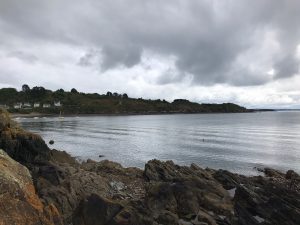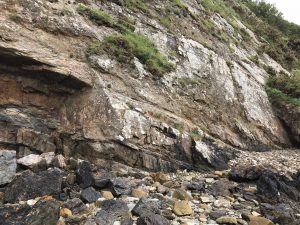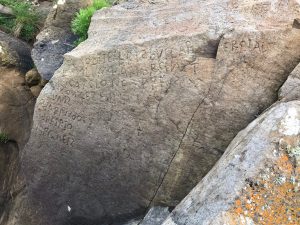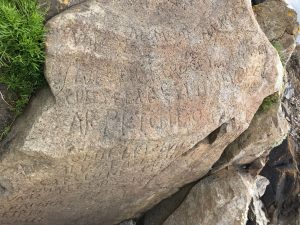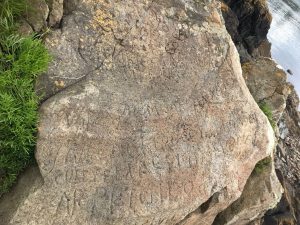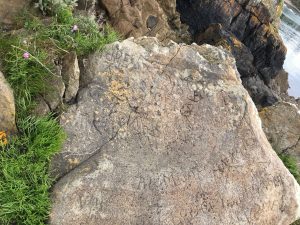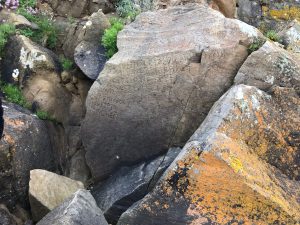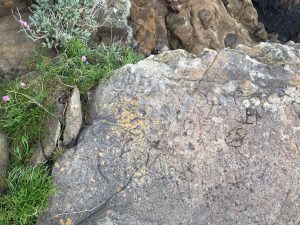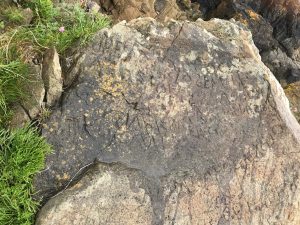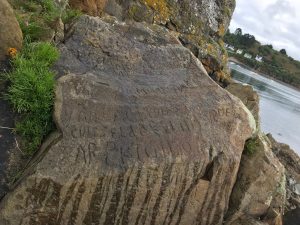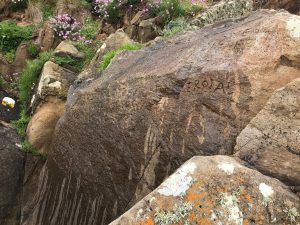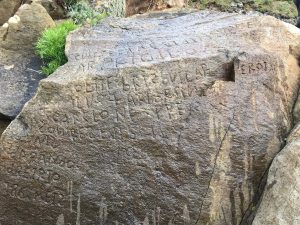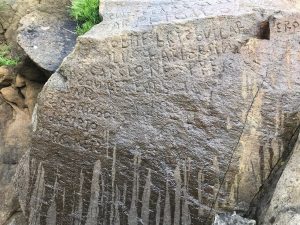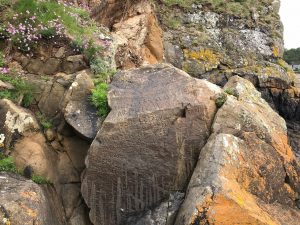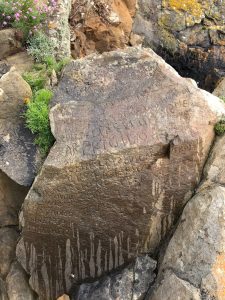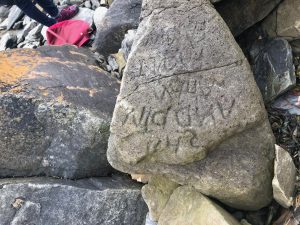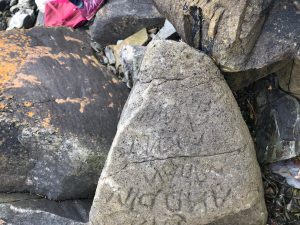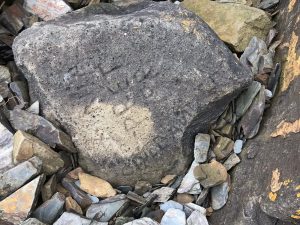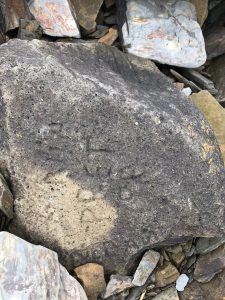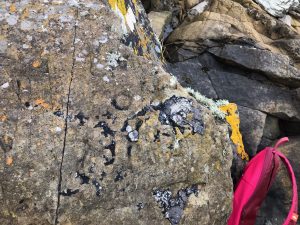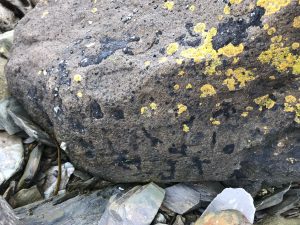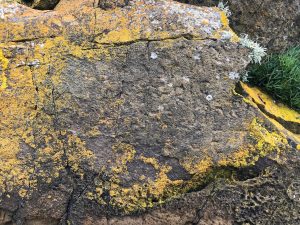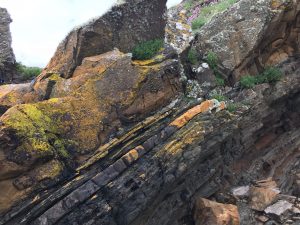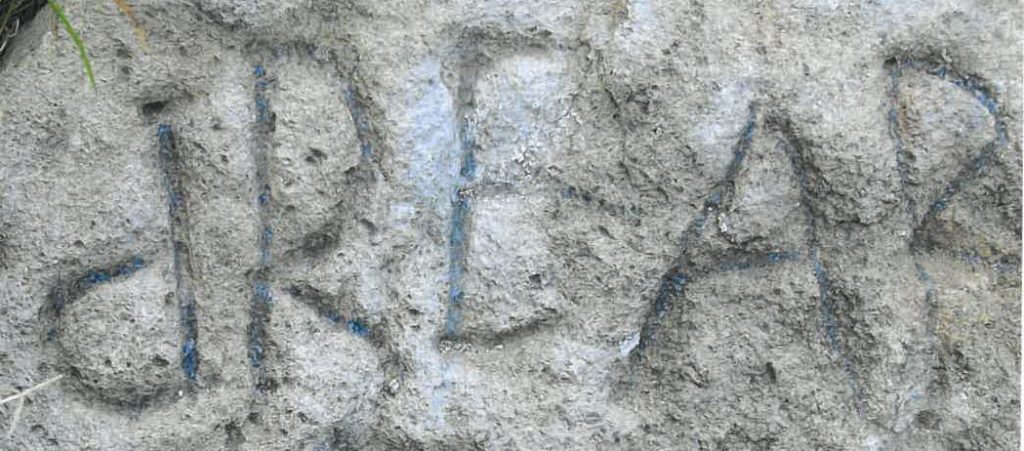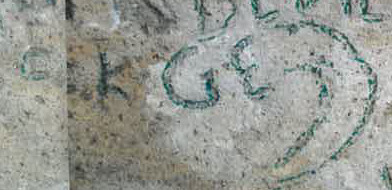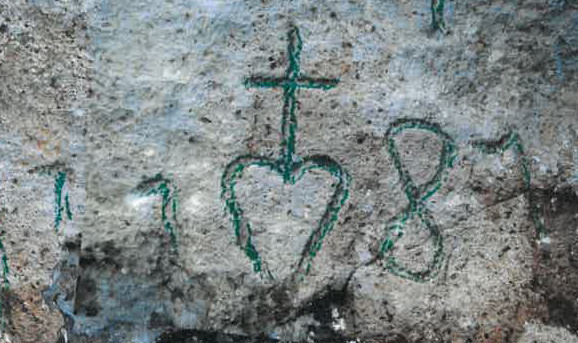I was recently sent a fascinating (and, at 88 pages, substantial) dossier by François Parmentier on the Plougastel-Daoulas inscriptions. It’s a very pleasant read (François is much to be applauded), and has pretty much everything you might need to bring you up to speed on the mystery surrounding these strange inscriptions. He also examines many of the assumptions and ‘Internet wisdom’ on the inscriptions, and finds them not to be true.
Because the dossier is in French, I’ve appended my translation of the first few pages below: I’ve omitted discussions of the entropy, index of coincidence and discussions of ciphers. What remains in the dossier largely consists of tables and annexes, which anyone interested should be able to easily follow.
The downside – which you may already have guessed – is that none of the lines of enquiry he follows leads anywhere particularly solid. But in many ways that also (I think) means that François should be commended on his transparency – this openness means his research loss becomes everyone’s gain. 🙂
Incidentally, one idea for future work suggested right at the end of the dossier is to look at gallo (the Vendée patois). This is because even if the Sacred Heart turns out (as is possible) to be linked to the Chouannerie, François found no “use of the Sacred Heart on the part of Breton Chouans: to my knowledge, only the Vendeans adopted it“.
Anyway, one final round of thanks to François Parmentier: and now on with my normal free-wheeling translation. All mistranslations are mine, etc. Enjoy!
Nick’s Translation of the First Few Pages…
This document does not pretend to precisely decrypt the inscription left on the rocks at Anse du Caro. Rather, its purpose is to attack the problem as rationally as possible, and in a logical sequence. Hence Part I contains information concerning the inscription; Part II the result of an automated analysis of the inscription; and Part III a theory / attempted decoding leading (…or not) to a meaningful plaintext. However, given that things become more uncertain as the pages proceed, Part IV consists not of answers but of perspectives and provisional conclusions.
Maybe one of the attempts made here will prove to be a way in to the mystery of this inscription; or maybe not. Or perhaps the data presented here will help other researchers determine the inscription’s meaning. Anyway, I present this file to the (virtual) jury, hoping that it brings it much to reflect upon.
Part I. Givens of the problem
I.1. Historical-geographical context
In order to avoid overburdening this (already substantial) file, here is a brief summary:
- Geography:
- Coordinates: 48 ° 34 ’50 “20 ‴ N, 4 ° 44′ 41” 06 ‴ W;
- The rock is near the Anse du Caro, a few hundred meters from Ilien-en-Traoñ, on the Plougastel-Daoulas peninsula in Brittany.
- History:
- Unknown date of creation: all the same, it has become conventional to ‘read’ three dates on the rock: 1787, 1786, 1771 (with the implication that one should select the last of the three as the most probable candidate date of creation);
- 1920: apparently inscribed by a Russian soldier;
- 1979: Bernard Tanguy mentioned the inscription to the Société Archéologique du Finistère ;
- 1984: Article by Yves-Pascal Castel in the Bulletin de la Société Archéologique. Presentation of a first transcription;
- May 2019: Launch of a decryption contest, after several approaches to specialists yielded nothing.
I.2.Transcription of the text
As mentioned above, the first transcription of the inscription was made by Yves-Pascal Castel in 1984; a second attempt was provided by the Mairie in the recent competition documentation: they both appear, commented, in Appendix 3. Using the photographs provided by the town hall and those on Internet, and with the overlaps made with these two previous transcriptions, what follows below is a new transcription: this is what we will primarily work with throughout this document.
The transcription is presented as follows: on the left is a text identifier of the text, consisting of a letter designating the rock and a line number. More information on the numbering system is in Annex 2. Underscores indicate one or more indecipherable letters; the paragraph shows that the inscription does not begin to the very left of the rock, but is (more or less) right justified.
A1 GROCAR
A2 dREAR DIOƧEEVbIO
A3 ARVREOИEƧLAΘhVEC
A4 PEИ AbEИEИEƧΘI8ƧE +
A5 ИbICEИG
A6 _OAИI EKGE
A7 AƧOMGAROPA ɣCDO’FET
A8 dAR OA
A9 O I E EM __ GEM E JAIEJ
A10 IVEL AChEODCET DA-AOMA
A11 CVLES ELdA RE IdIMEVƧMEƧ
A12 I __R ER
A13 AR PRIGIL O d11(Coeur orne d’une croix)81
A14 ObIIE bRIƧbVILN EROIAL
A15 ALVO4 ARbORSIV_T
A16 CARCLO IVE PRE Ƨ T
A17 VƧOИ REƧ E_____ I
A18 VA_Ƨ 1920
A19 ƧdARANdOC
A20 AdREIRIO
A21 I186 ИEIƧ
B1 Ƨh_
B2 AND PIN
B3 _A_AИ
B4 _A_VET
B5 _AM__
C1 ____A
C2 _ PRET
C3 OR
C4 ONE_AИ_ __
D1 __E_
D2 O
D3 VET
D4 I__T
E1 __OИR
E2 __RIC
E3 __R_
E4 __CE_
There are, of course, many obstacles to a ‘perfect’ transcription of this inscription.
All things considered, some spaces and even some lines are highly debatable (see A. A8). Similarly, various signs that are interpreted here as falling in the same category could well be distinct: I do not differentiate between the small raised o (1. A10) and the full-size O (A13); nor between a sans-serif vertical line (1. A2) and a similar vertical line with serifs at the ends (1. A13); or between a very clear and straight V (A1) and another more curved specimen (beginning of 1. A11). Some decisions had to be taken during this transcription, particularly with the difference between “IV” and “N”: here, three criteria were used – the junction between the I and the V, the inclination of the two characters, and their (relative) size.
I also find the question of the dates (allegedly) observed very difficult, because I do not see the elements mentioned in the previous transcriptions. The date around the heart in A13 (if it is indeed a date), seems to me to be “1181”, because all 1-shapes have a serif at the top turned to the left, and have no middle bar. I see the same-shaped character in the second l on A21, while the first has no serif at all: hence I transcribed that as I.
Thus, if the analyses carried out on this transcription fail, it could well be because specific transcription choices I made were faulty. In this case, it would therefore be necessary to provide a finer-grained transcription, which should take into account the size and orientation of the characters, the presence (or absence) of serifs, etc. To do this, a trip to the rocks themselves would probably be necessary, to touch (like Saint Thomas) the signs and thereby better understand them. In particular, one might use such an opportunity to examine some particularly intriguing characters:
- The final C of line A3, which is very angular but lacks a middle bar (i.e. to make an E);
- The beginning of the A4 line;
- The possible presence of characters before the inscription of line A5;
- The apostrophe in A7 (hapax) might simply be an I belonging to the line A6
I.3.Typical elements of the inscription
Apart from numbers, the text contains three non-alphabetic elements:
- A discreet, non-stylized cross (A4);
- What is commonly characterized as a left-facing crescent moon (1. A6);
- A heart surmounted by a cross (L. A13).
Unfortunately, we can deduce little about the first two of these, given that they are so generic. The cross might simply be an addition sign, or might follow a religious text (as, from time to time, crosses appear inserted in the text in breviaries). The crescent – if it is really a crescent – could be an astrological / astronomical symbol, and thus would give us no further help.
The most intriguing of these symbols is therefore the heart surmounted by a cross, commonly associated with the Sacred Heart of Jesus.
Devotion to the heart of Christ is an old tradition, but one that grew considerably in France in the seventeenth and eighteenth century, thanks to saints such as Jean Eudes and Marie Alacoque. In 1670, the Feast of the Sacred Heart, nineteen days after Pentecost, was instituted in the diocese of Rennes: this was extended throughout France and then to the entire Church. In the Plougastel inscription, the representation of the Sacred Heart would therefore seem to fit well with the traditional reading of the dates 1787 (1. A13) and 1786 (1. A21).
Later on, the Sacred Heart becomes the emblem of the Chouan royalist uprising, which took place in Brittany; this symbol remains the current emblem of the Vendée. Personally, I consider this link quite likely, because it is so strongly iconic, even if it does pose a question for those who believe the traditional reading of dates on the inscription, because 1786/1787 were 7/8 years before the whole Chouannerie episode began. Note that the reading of the above-mentioned dates raises questions for another reason: if we assume that the last line (1. A21) gives the date of writing of the text, the dates on line A13 designate years which had not yet happened. This would hence have to be a prediction or some vision of the future: unless, of course, they are simply nothing more than just dates.
Finally, there is also the engraving on rock E (if I’m not mistaken), commonly referred to as the “sailboat”. In truth, though, the engraving is not very legible, and shows mostly straight lines converging towards the same point. To make interpretation even more difficult, the rock seems broken close to the base of the engraving. As a result, this detail, although possibly critical, remains largely unusable.
Part II – Analyses of the Inscription
II.1. Frequency analysis
- 32 characters: 25 alphabetical, 4 digits and 3 typographic symbols;
- Most of the alphabet is Latin and capitalized, but has some non-Latin characters: Ƨ, И, d, b, h, Θ and ɣ;
- The 10 most frequent characters: E, A, R, I, O, Ƨ, V, C, I, L (73.03%
cumulative frequency).
II.2. Algorithm for Determining the Vowels
Several algorithms exist to determine which characters in a text are vowels or consonants: but none is infallible. The best known is probably that of Sukhotin: here, I use Mans Hulden’s OCPb algorithm (Obligatory Contour Principle based), posted online by its author. This algorithm is very effective – it yields only 7 errors when analyzing a corpus of 503 languages.
Overall, it seems that vowel letters do indeed refer to vowels and consonants letters to consonants;
- Among the special characters, the OCPb algorithm classifies h and ɣ as vowels, and Θ, Ƨ, И, b and d as consonants;
- The characters 1, 8, 6, K, F, h, + and ‘ are very unstable according to the algorithm, the variant and the corpus used;
- On the contrary, the stable letters are: A, E, I, O, ɣ (vowels); Θ, S, N (coronal consonants); J and L (non-coronal consonants).
II.3. Phonotactic analysis
Phonotactic analysis describes the probabilities that one letter is followed by another for each of the characters used in the alphabet.
The analysis has been conducted here on two different corpuses: one with the transcription spaces proposed above, the other only interpreting the line-ends as spaces. In all cases, unknown characters have been replaced by spaces. The results obtained appear in Appendix 5; the salient points are:
- 3 repetitions of letters: 11, EE and II;
- Vowel groups (identified in II.3) are: EE,
EO, EA,
EI, EK, OA, OI, AO, (AA), Al, (Aɣ), IE, IO, IA, II, hE; - The bigram “AR” is strangely frequent;
- The letter T always appears at the end of the word.

